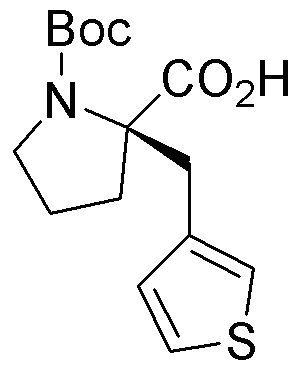Boc-(R)-a-(3-thiophenylmethyl)proline is widely utilized in research focused on:
- Pharmaceutical Development: This compound serves as a key building block in the synthesis of peptide-based drugs, particularly those targeting neurological disorders, enhancing therapeutic efficacy.
- Biotechnology: It is used in the design of novel biomolecules, aiding in the creation of targeted drug delivery systems that improve treatment precision and reduce side effects.
- Material Science: The compound plays a role in developing advanced materials, such as polymers and coatings, that require specific chemical properties for enhanced durability and performance.
- Research in Organic Chemistry: It is a valuable reagent in organic synthesis, facilitating the formation of complex molecules through various coupling reactions, thus streamlining research processes.
- Analytical Chemistry: The compound is employed in the development of analytical methods for detecting and quantifying thiophene derivatives, contributing to quality control in pharmaceuticals.
General Information
Properties
Safety and Regulations
Applications
Boc-(R)-a-(3-thiophenylmethyl)proline is widely utilized in research focused on:
- Pharmaceutical Development: This compound serves as a key building block in the synthesis of peptide-based drugs, particularly those targeting neurological disorders, enhancing therapeutic efficacy.
- Biotechnology: It is used in the design of novel biomolecules, aiding in the creation of targeted drug delivery systems that improve treatment precision and reduce side effects.
- Material Science: The compound plays a role in developing advanced materials, such as polymers and coatings, that require specific chemical properties for enhanced durability and performance.
- Research in Organic Chemistry: It is a valuable reagent in organic synthesis, facilitating the formation of complex molecules through various coupling reactions, thus streamlining research processes.
- Analytical Chemistry: The compound is employed in the development of analytical methods for detecting and quantifying thiophene derivatives, contributing to quality control in pharmaceuticals.
Documents
Safety Data Sheets (SDS)
The SDS provides comprehensive safety information on handling, storage, and disposal of the product.
Product Specification (PS)
The PS provides a comprehensive breakdown of the product’s properties, including chemical composition, physical state, purity, and storage requirements. It also details acceptable quality ranges and the product's intended applications.
Certificates of Analysis (COA)
Search for Certificates of Analysis (COA) by entering the products Lot Number. Lot and Batch Numbers can be found on a product’s label following the words ‘Lot’ or ‘Batch’.
*Catalog Number
*Lot Number
Certificates Of Origin (COO)
This COO confirms the country where the product was manufactured, and also details the materials and components used in it and whether it is derived from natural, synthetic, or other specific sources. This certificate may be required for customs, trade, and regulatory compliance.
*Catalog Number
*Lot Number
Safety Data Sheets (SDS)
The SDS provides comprehensive safety information on handling, storage, and disposal of the product.
DownloadProduct Specification (PS)
The PS provides a comprehensive breakdown of the product’s properties, including chemical composition, physical state, purity, and storage requirements. It also details acceptable quality ranges and the product's intended applications.
DownloadCertificates of Analysis (COA)
Search for Certificates of Analysis (COA) by entering the products Lot Number. Lot and Batch Numbers can be found on a product’s label following the words ‘Lot’ or ‘Batch’.
*Catalog Number
*Lot Number
Certificates Of Origin (COO)
This COO confirms the country where the product was manufactured, and also details the materials and components used in it and whether it is derived from natural, synthetic, or other specific sources. This certificate may be required for customs, trade, and regulatory compliance.


